THE SMALL 1 × 1
OF SUSTAINABLE LAWN MAINTENANCE
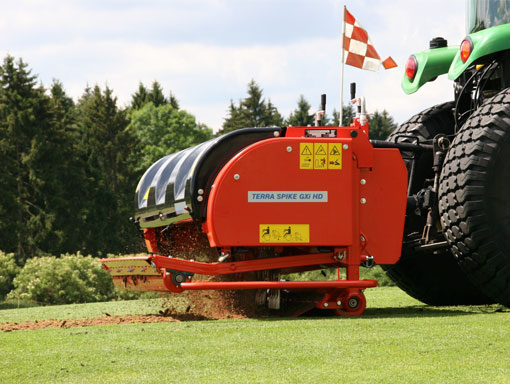
Aerification / Ventilation
The micro-organisms in the soil as well as the grass roots require oxygen for the metabolic process to take place. The process is called aeration whereby openings are created in order to supply oxygen to the root area. For this, a range of suitable equipment complete with different tools and accessories are available. It begins with a simple slitting machine equipped with slitting or loosening blades. Some slitting devices can also be fitted with coring tines. High performance aerators are now PTO-driven and can be used with solid or coring tines. The usual working depth corresponds to the main root horizon, i.e. approx. 10 cm.
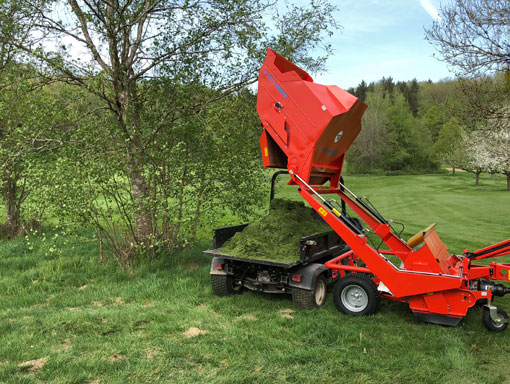
Collection
Scarifying with integrated collection and combing followed by clearance of the lawn and grassed areas results in the removal of turf thatch, grass tillering stimulation, a reduction in the organic matter, an enhanced water balance in the soil as well as leading to aeration of the upper root horizon.
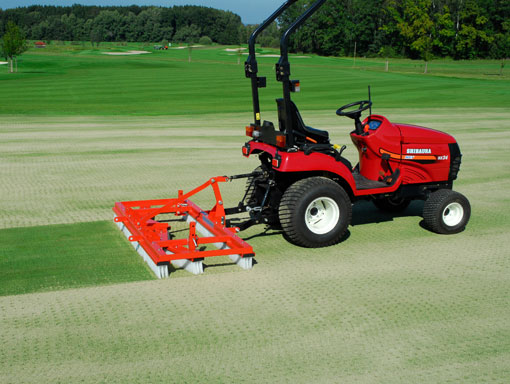
Brushing
If artificial turf playing surfaces are used intensively, it is impossible to avoid accumulations or the appearance of backfill material in heavily frequented areas. The bedding material is transported over the whole area during usage and by the wind. The material is returned to its original position through the use of a brushing system. A combination of the brushing system complete with a combing mechanism or magnetic strips increases the efficiency of the devices. In the process, the leading combing device or decompacting brush has the task of vertically positioning the artificial turf fibres and loosening the compacted granulate. In any event, levelling is the second step. Preliminary cleaning takes place before levelling. This means, leaves and other items of foliage in particular have to be cleared away from the surface in order not to be subsequently worked into the playing surface.
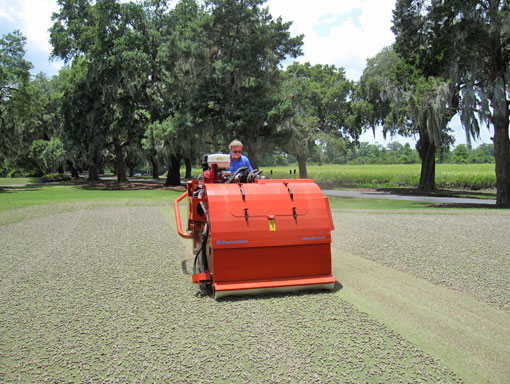
Core recycling
For collecting and recycling cores
Several working operations are usually required to remove excavated cores and fill the aeration holes with fresh sand. The unique CORE RECYCLER performs these tasks in one operation thereby reducing aeration time and effort as well as keeping any related costs that arise to a minimum. As the CORE RECYCLER recycles up to 80% of the soil substrate, the amount of expensive top dressing materials used is significantly reduced. This saves money and also takes sustainable plant protection into account because the valuable micro-organisms are retained in the recycled turf base material. In addition, this helps the plant to absorb nutrients and water, strengthen the plant’s immune system and allow the treated areas to recover more rapidly. The use of pesticides is likewise reduced and the treated areas can be used again far more quickly. The advantages of the CORE RECYCLER were proven in a scientific study carried out by the renowned British Sports Turf Research Institute (STRI).
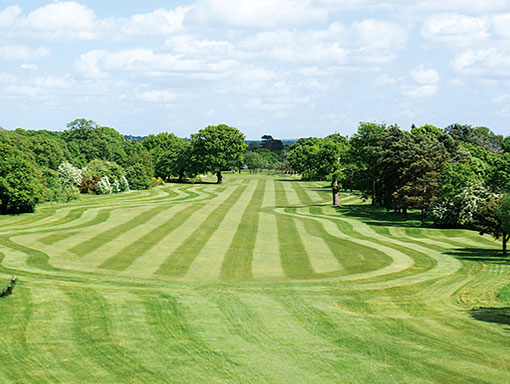
Mowing
Mowing the lawn in the right way
Grass is a piece of nature which has very different functions.
The distinction between landscaped, ornamental, sports and utility lawns alone makes it clear what different tasks the lawn grasses take on and which different maintenance requirements there are to be carried out.
A landscaped lawn is primarily used to provide protection against erosion. Hence, deep-rooted, drought-resistant grasses are predominantly used here. Only minimum requirements are made with regard to cutting operations. Grass clippings are only disposed of where it is necessary due to the surrounding conditions, e.g. in the roadside greenery. In addition to flail mowing, sickle mowers with rear or side ejection are also used here.
Ornamental lawns have mainly aesthetic functions to fulfil. The top requirement is creating a lush green-looking, dense lawn. Mulching or recycling technology are options when maintaining ornamental lawns. The background to this technology is that the clippings are very finely shredded and remain on the surface. In order to achieve an optimal result, the so-called 1/3 rule should always be followed. This rule states that when mulching or recycling, a maximum of 1/3 of the growth height should be removed when cutting. Compliance with this rule is necessary so that the clippings can be “hidden” in the remaining sod and the metabolism process of the grass plants is not excessively damaged. The finely shredded clippings are used to supply the plants with nutrients after they have been transformed by soil organisms. Cylinder mowers as well as sickle mowers with rear/side ejection or recycling are particularly suitable for maintaining ornamental lawns.
When it comes to the maintenance of sports and utility grass surfaces, the focus is placed on the functional properties. The cutting heights range from 10 cm, e.g. on horse racing tracks, down to less than 5 mm as for golf greens. Regarding the correct mower selection, the soil structure along with the functional requirements of the playing area are important for sports and utility lawns. Up to a cutting height of 20 mm, cylinder mowers are exclusively used whilst sickle mowers are mainly utilised for anything above this.
Finely structured clippings can remain on areas with a strong degree of soil life. This is quickly absorbed and serves the supply of nutrients. As a rule, there is little soil activity on very sandy areas. Therefore, the clippings on these areas should be vacuumed up or swept away after mowing. If the clippings remain on the surface, a so-called “felt layer” is created which acts like a sponge on water and fertilizer. As a result, root growth is reduced and turf resilience decreases whereby a slippery surface is formed which is unsuitable for playing sports.
Summing up, it can be said that sickle mowers are ideally suited for a variety of lawn maintenance applications. Combined with a grass collection system or mulching or recycling devices, optimal results can be achieved according to requirements. Only a few manufacturers offer complete solutions for functional, professional lawn care.
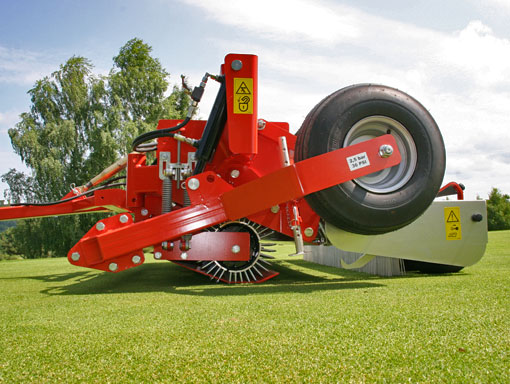
Reseeding
Intensively used turf areas are subject to natural wear and tear. In order to counteract this, reseeding is required in addition to other measures. In the process, seeds are planted in the soil using different methods. With the broad seeding method, seeds are placed over a wide area on the lawn and worked into the ground by means of combing. Alternatively, the perforation seeding method is used. Here the soil is perforated with suitable tools (hollow tines, solid tines or slitters) and the seeds are brushed into the openings. Soil closure of the seed is the most important factor when reseeding. This means that the seed must be properly planted in order not to dry out and to anchor itself in the soil after germination. Suitable products for this are the Wiedenmann Terra Seed as “broad seeding”, or alternatively the Terra Float / Terra Slit series complete with reseeding unit (as perforation seed).
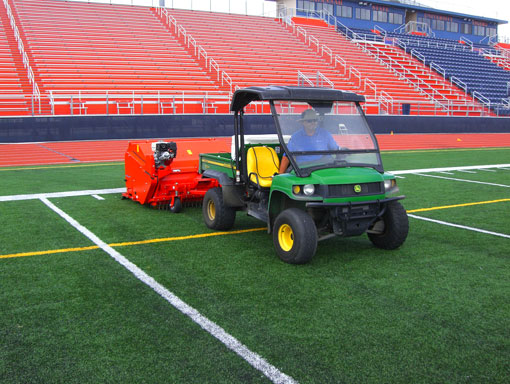
Cleaning
Artificial turf sports facilities – artificial playing surfaces in a natural environment – which are subject to environmental influences right from the start of their installation. “Just giving it the once over with a broom now and then” is simply not enough to provide the pitch with its required playing characteristics.
Regular cleaning and maintenance are therefore essential components for ensuring value retention. Coarse dirt such as leaves, twigs, small stones, cigarette butts, bottle caps, etc. must therefore be removed from the surface on a regular basis.
Foliage in particular poses a problem when it comes to maintenance before it is properly processed by the levelling brushes. It is shredded and then forced into the surface underfoot. This fundamentally worsens the playing characteristics.
Suitable maintenance equipment used here are sweepers with riddle screens that ensure that the backfill material is once again directly supplied to the artificial turf pile. Larger amounts of leaves and foliage are best blown off and collected outside the artificial turf surface by means of a turf sweeper or clippings collector and then disposed of.
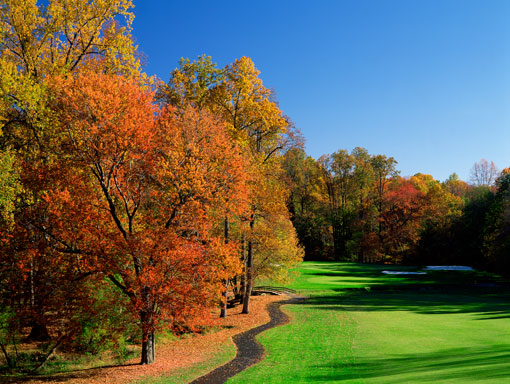
Suction
Autumn leaves
Im Wechsel der Jahreszeiten ist der Laubfall und damit die Notwendigkeit der Entsorgung eine immer wiederkehrende Aufgabe.
Geeignete Geräte dazu sind die Gras- und Laubsauger in Verbindung mit Front- oder Zwischenachsmähwerken. Hier kann neben der Laubaufnahme gleich noch der letzte Schnitt auf der Rasenfläche durchgeführt werden. Durch die Laubaufnahme über das Mähwerk wird das Laub vorzerkleinert, was die Schüttdichte im Behälter erhöht und die nachfolgende Kompostierung beschleunigt.
Alternativen sind die Rasenkehrmaschine sowie die Universal-Pflegegeräte. Bei letzteren ist im Gehäuse einer Rasenkehrmaschine ein Universalrotor installiert, auf dem Vertikutier- oder Schlegelmesser in Verbindung mit Windpaddeln montiert werden. Auch damit ist die Kombination aus Rasenschnitt und Laubaufnahme mit Vorzerkleinerung realisierbar.
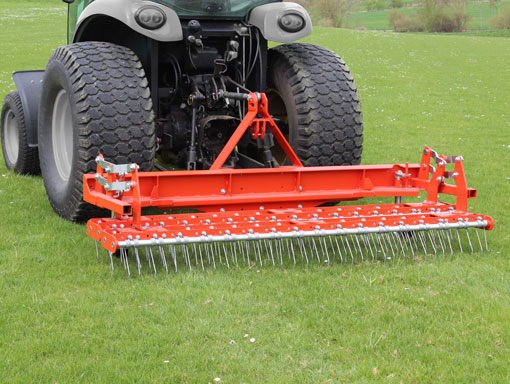
Combing
In addition to the turf plant, we also find dead plant material and clippings on grassed areas. If allowed to remain on the surface, this will result in the formation of thatch, a sponge-like layer that stores water and nutrients and thus prevents the grass roots from growing deeper into the soil. This leads to problems with surface resilience.
By means of combing or scarifying (vertical cutting), this dead material is efficiently removed from the sod and is then collected in a further working step. The usual working depth for this procedure is approx. 5 mm.
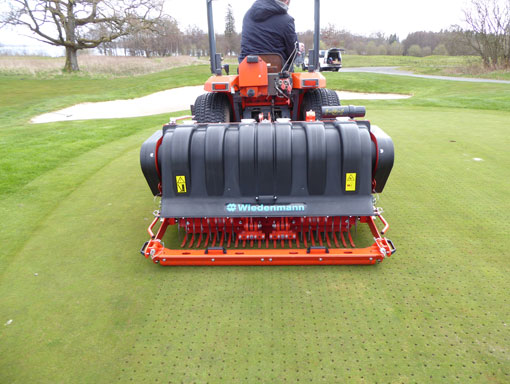
Loosening / Deep Spiking
Natural lawns and turf are subject to tremendous demands through use and maintenance. This leads to compaction in the area of the roots and subsoil. Normally, a turf base layer for sports fields and laying areas has a 25% proportion of fine pores that can store water and a 25% proportion coarse pores which is responsible for a gaseous exchange and drainage. In particular, the proportion of coarse pores decreases rapidly due to the compression resulting from the load exerted from above. With an oxygen percentage of less than 10% in the soil, lasting damage to soil organisms and subsequently to the turf plant can be expected. In order to counteract this, deep spiking devices are used. Deep spikers function in a number of ways. The most commonly used devices work with solid tines according to the principle of a digging fork. The tines penetrate the ground, are then pivoted in the soil and subsequently pulled out. The resulting cavities in the soil profile break up any compaction and ultimately improve water permeability. The working depth of these devices depends on the existing soil structure and compaction horizons. In the case of constructed areas such as modern sports fields, work is carried out up to a depth of approx. 20 cm; for natural soils, the required working depth can reach 35 cm.
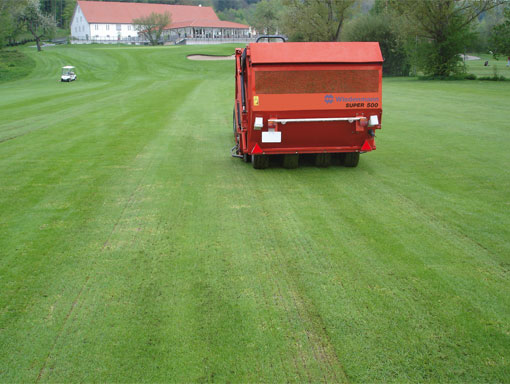
Scarification
In addition to the turf plant, we also find dead plant material and clippings on grassed areas. If allowed to remain on the surface, this will result in the formation of thatch, a sponge-like layer that stores water and nutrients and thus prevents the grass roots from growing deeper into the soil. This leads to problems with surface resilience.
By means of combing or scarifying (vertical cutting), this dead material is efficiently removed from the sod and is then collected in a further working step. The usual working depth for this procedure is approx. 5 mm.
